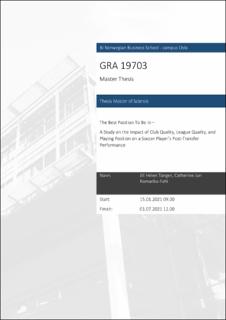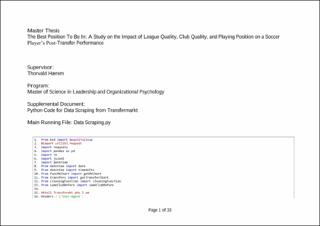| dc.contributor.author | Tanger, Jill Helen | |
| dc.contributor.author | Romadka-Fahl, Catherine Jun | |
| dc.date.accessioned | 2021-10-14T11:37:55Z | |
| dc.date.available | 2021-10-14T11:37:55Z | |
| dc.date.issued | 2021 | |
| dc.identifier.uri | https://hdl.handle.net/11250/2823009 | |
| dc.description | Masteroppgave(MSc) in Master of Science in Leadership and Organizational Psychology - Handelshøyskolen BI, 2021 | en_US |
| dc.description.abstract | Today, more and more companies are struggling to develop internal talent at the
same speed that the world changes. Therefore, it has become a common practice
to search for high-performing talents on the external market. While this sounds
simple, research within the field of inter-organizational transfer gives reason to
believe that not every high performer will be able to replicate their prior
performance right after transfer. Though conclusions have been made that several
factors are helpful in aiding a transferee’s post-transfer performance, research
lacks insights on how the overall difference between job positions can affect it. In
this study, we explore how different job positions affect portability in addition to
confirming previous research findings. We do so by applying these ideas to the
realm of soccer. The soccer industry shows high similarities to organizations
outside of sports, and it offers the benefit of providing a high number of transfer
occurrences and more easily accessible data. Using a data set of the most valuable
soccer transfers in the last decade, we come to conclude that organizational
capabilities in terms of the club and league quality impact a player’s post-transfer
performance. Furthermore, we see the impacts of positional differences on soccer
players’ post-transfer performances. While we conclude that organizational theory
is not perfect in explaining soccer performance after a transfer, it does give reason
to believe in the importance of a transferee’s position. The insight gained from
this study suggests that a job position’s effect on post-transfer performance should
also be further investigated in organizational research. | en_US |
| dc.language.iso | eng | en_US |
| dc.publisher | Handelshøyskolen BI | en_US |
| dc.subject | ledelse | en_US |
| dc.subject | organisasjonspsykologi | en_US |
| dc.subject | leadership | en_US |
| dc.subject | organizational psychology | en_US |
| dc.title | The Best Position To Be In – A Study on the Impact of Club Quality, League Quality, and Playing Position on a Soccer Player’s Post-Transfer Performance | en_US |
| dc.type | Master thesis | en_US |

